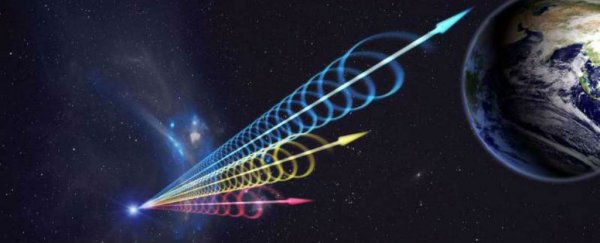For almost 10 years, astronomers have been trying to track down the source of mysterious cosmic radiowaves called Fast Radio Bursts (FRBs), which are brighter than our Sun, packed with energy, and flash across the Universe in random directions thousands of times a day.
While they're believed to originate somewhere in the distant Universe, scientists have had a hard time figuring out these strange bright flashes since their discovery back in 2007, because each of them lasts for a mere faction of a second before disappearing. But recent analysis of more than 650 hours of archival data has brought us closer than ever to an answer and it turns out that a starquake - like an earthquake but on a star - could be the source.
Using information gathered by the US National Science Foundation's (NSF) Green Bank Telescope (GBT), a team of astronomers has put together the most detailed record ever of an FRB. From this FRB - called FRB 110523 - they've discerned that these radio waves are being produced in a highly magnetised region of space, which could place them in close proximity to a supernova (an exploding star) or inside an active star-forming nebula.
"We now know that the energy from this FRB passed through a dense, magnetised region shortly after it formed. This significantly narrows down the source's environment and type of event that triggered the burst," said astronomer Kiyoshi Masui from the University of British Columbia in Canada.
Sifting through the 40 terabytes of data we have on this single FRB, Masui and his colleagues used the 'smear' that affected the signal of the radio wave as it travelled to figure out that it originated in some other galaxy around 6 billion light-years away - about halfway across the Universe.
This is the first time scientists have found proof that FRBs are visitors from a galaxy outside of our own.
The signal smears Masui and his team analysed have been recorded since the first FRB was detected by West Virginia University astrophysicist Duncan Lorimer and colleagues, based on information picked up by the Parkes radio telescope in Australia.
"The more smeared a radio signal is, the more plasma it has passed through, and the farther it has presumably traveled through space," says Lee Billings at Scientific American. "Analysing the smear, Lorimer and his collaborators made a rough estimate that the burst could've come from up to a few billion light-years away."
That means these things are coming from well beyond the outskirts of our Milky Way galaxy, so each one is capable of releasing between an hour's to a year's worth of our Sun's total energy output in just a few milliseconds, says Billings.
Masui and his team also analysed the polarisation of FRB 110523 - something that no one's been able to do until now. "Hidden within an incredibly massive dataset, we found a very peculiar signal, one that matched all the known characteristics of a Fast Radio Burst, but with a tantalising extra polarisation element that we simply have never seen before," said Jeffrey Peterson from Carnegie Mellon University.
The twisted, corkscrew-like nature of this FRB's polarisation indicated that it had travelled through a very powerful magnetic field, and further investigation revealed that its light had been scattered by something soon after zooming away from its source. This hinted at the possibility of it originating in a dense cloud of plasma.
Elizabeth Gibney explains what that could mean at Nature:
"A plasma-filled region suggests an area of space where stars are still forming. Combined with the magnetic field, Masui says that this could mean that the FRB came from a starquake - a disturbance in a star's crust, similar to an earthquake - in a young magnetar, a strongly magnetised neutron star. Alternatively, he says, a young but particularly big neutron star could have released the burst as it suddenly collapsed to form a black hole, something known as a blitzar."
More anaysis will need to be done on other FRB's, but we're getting seriously close to figuring out these mysterious random flashes in the Universe.
The results have been published in Nature.
